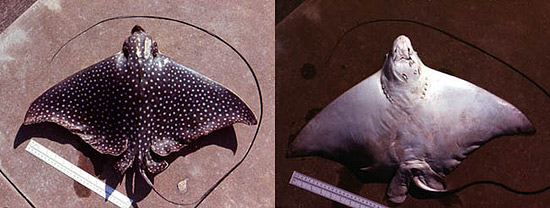Morphology & Functionality

picture from: https://www.floridamuseum.ufl.edu/discover-fish/species-profiles/aetobatus-narinari/
External Morphology & Locomotion
The spotted eagle ray is “easily recognized by its blue or black top dotted with white spots, white belly, and flat “duck bill” snout. There are five small gills on each side of the front half of the belly. The tail is very long and features two to six venomous spines located just behind the pelvic fins.”1 Additionally, the species have “dorsoventrally compressed body plans, with nostrils on the ventral side of their body.”2 As for the fins, “Pectoral fins are extremely pronounced – forming wing-like appendages used for primary locomotion. Head is obvious, with flattened, tapered snout. Caudal fin is heavily modified into a whip-like form (typical of ray species). Venomous spines (1–5) may be found along base of caudal fin’s dorsal surface.”3
Sensory
Like many batoids, the spotted eagle ray relies heavily on olfaction as their primary sense to navigate the ocean.4 Additionally, their nostrils are located underneath the species so they rely on this when it comes to feeding due it being in close proximity to its mouth.5
Feeding
For dentition, the “spotted eagle rays possess flat plates of teeth which are used to crush the hardened shells of preys items such as bivalves and crustaceans”6 and possess “calcified jaws and chevron-shaped teeth to crack open hard shells.”7
A study by Cambridge University Press concluded that of 154 specimens, 68 females and 86 males, “The results indicated that A. narinari near Campeche is a specialist and selective predator that feeds mainly on gastropods (92.7% IRI), with no significant differences in the diet found between sexes, size groups, or between stomach and intestine contents.”8 Additionally, the “most important prey species were Strombus pugilis (53.33% IRI) and Americoliva reticularis (25.6% IRI). Other prey species included Lobatus costatus (5.6% IRI) and Petrochirus diogenes (3.6% IRI).”9
In a study called Diet and reproduction in the white-spotted eagle ray Aetobatus narinari from Queensland, Australia and the Penghu Islands, Taiwan, it was found that there were “Minor dietary shifts from a gastropod–crustacean to a more gastropod–bivalve based diet occurred as body size increased.”10 This means that the typical prey of choice are gastropods and bivalves and it doesn’t often change based off of location and size.
An additional study from MDPI confirms these findings by stating in their Diet and Feeding Ecology of the Whitespotted Eagle Ray (Aetobatus narinari) from Florida Coastal Waters Revealed via DNA Barcoding study that “Results from the sequenced data indicate that the whitespotted eagle ray diet in Florida is mainly comprised of bivalves and gastropods, with variable inclusion of crustaceans. Despite positive identification of venerid clams, there was no evidence for the consumption of hard clams (Mercenaria spp.), a major shellfish aquaculture and restoration species in Florida. Such wide-ranging prey species from various trophic guilds and locations highlight the whitespotted eagle ray’s diverse role in the top-down regulation of coastal benthic communities.”11
Sources
- https://www.thoughtco.com/spotted-eagle-ray-facts-4587348 ↩︎
- https://doi.org/10.1093/iob/obac043 ↩︎
- https://seaworld.org/animals/facts/cartilaginous-fish/spotted-eagle-ray/ ↩︎
- https://doi.org/10.1093/iob/obac043 ↩︎
- https://youtu.be/YmoZbpdwVxU?si=ZJXpkXuxcfIlmp0O&t=58 ↩︎
- https://seaworld.org/animals/facts/cartilaginous-fish/spotted-eagle-ray/ ↩︎
- https://www.thoughtco.com/spotted-eagle-ray-facts-4587348 ↩︎
- https://doi.org/10.1017/S0025315418000450 ↩︎
- https://doi.org/10.1017/S0025315418000450 ↩︎
- https://doi.org/10.1071/MF09261 ↩︎
- https://doi.org/10.3390/fishes8080388 ↩︎